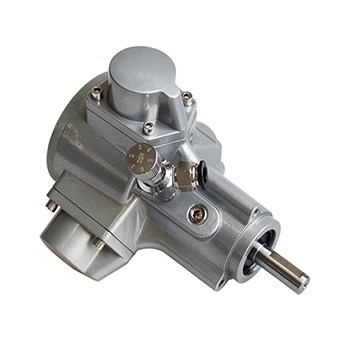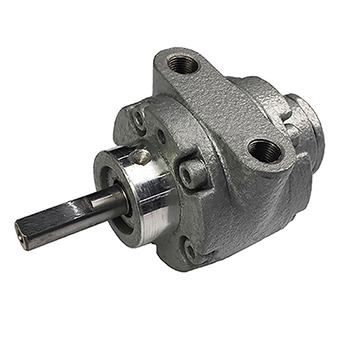What is the Difference between a Vane and Piston Air Motor?
Air motors can be divided into two types, piston air motors, and vane air motors. These two motors have different advantages and are widely used in industry. We will introduce you to the different working principles and application scenarios of vane and piston air motors.
Working principle differences
Piston air motor:
It is a power device that converts the linear motion of the piston into rotation through the crank mechanism. During this period, the friction force of the piston movement is relatively large, so the speed is low; the blade type directly drives the blade to rotate, and the friction force between the blade and the stator is small, so the speed is high. In terms of output, the piston type has a larger pressure-bearing area and higher output torque; the blade type has a lower output, but the fan only needs the speed and does not need torque.
The power generated by a piston air motor depends on the intake pressure, the number of pistons as well as the piston area, stroke, and speed. At any given inlet pressure, it is possible to operate at higher speeds. So with a larger piston diameter, a longer-stroke air motor gets more power.
Compressed air is fed into an airtight chamber that houses the piston shaft. Also inside this chamber, a spring is coiled around the axis of the piston to keep the chamber fully open when air is not pumped into the chamber. As air is fed into the chamber, the force acting on the piston shaft begins to overcome the force exerted on the spring. As more air enters the chamber, pressure increases and the piston begins to move downward. When it reaches its maximum length, the air pressure is released from the chamber and the spring completes the cycle by closing the chamber to return to its original position.
Vane air motor:
The rotating element is a slotted rotor, which is mounted on the drive shaft. Each slot of the rotor is fitted with freely slidable rectangular vanes. Depending on the design of the motor, the vanes are extended against the housing wall using springs, cam action, or air pressure. Air is fed into the pump via the motor, and the motor input pushes the vanes, which create a rotational motion of the central shaft. The rotational speed can vary from 100 to 10,000 rpm, depending on several factors, including the amount of air pressure at the air motor inlet and the housing diameter.
Vane air motors also have a limitation, which are internally lubricated. So they must be checked and re-greased regularly. They must be mounted horizontally to provide proper lubrication to the bearing area. The axial vane of the vane air motor is installed in the radial groove. The vane is eccentrically installed with the hole of the air motor housing. The vane is biased to seal the inner wall of the housing. The pressure acting on one side of the vane generates torque. The torque on the output shaft is proportional to the exposed vane area, the pressure, and the distance from the centerline of the rotor to the center of the exposed vanes (moment arm). The centrifugal force created by the rotation of the rotor assists in the sealing action.
Vane air motors operate at speeds from 100 to over 25,000 rpm, delivering more power per pound than piston air motors. While many require lubricated air, a growing number are designed to run non-lubricated to serve critical applications and address environmental concerns. In multi-blade air motors, the torque at a given speed can be increased by air pressure at the air motor inlet, increasing the pressure imbalance across the rotor blades.
However, there is a trade-off: increasing intake pressure increases air supply costs and generally results in faster wear and shorter blade life. Vane air motors are available with multiple vanes. The increased number of vanes reduces internal leakage or blow-by and makes torque delivery more even and reliable at lower speeds. But more blades increase friction, which increases the cost of the motor and reduces efficiency.
Application differences
Vane air motors typically provide low to medium power. Simple and compact vane air motors are an excellent choice in applications requiring high speed and low torque. They are most commonly used to power portable air tools but are also used in many other applications.
Stored energy in the form of compressed air, nitrogen, or air enters the sealed motor cavity and applies pressure to the rotor's blades. This causes the rotor to spin at high speed. Because the engine flywheel requires a lot of torque to start the engine, a reduction gear is used. Reduction gears produce high torque levels with low energy input. These reduction gears allow the engine flywheel to develop sufficient torque when meshing with the air motor or air starter's pinion. Vane air motors have been proven to be 70% practically efficient to start large industrial diesel or air compressors.
Piston air motors are used in applications requiring high power, high torque, and precise speed control at low speeds. They have three or five pistons, arranged axially or radially in the housing. The power produced by a piston motor depends on inlet pressure, number of pistons, piston area, stroke, and speed. The limiting factors are the inertia of the moving parts (which affects radial pistons more than axial piston motors) and the internal valves that control the intake and exhaust of the cylinder.
Radial piston motors are solid units, usually oil-lubricated, and ideal for continuous operation. They have the highest starting torque of any air motor. Radial piston motors provide torque and horsepower at relatively low speeds (less than 3000 rpm) and are commonly used to drive conveyors, rotate large pulleys and pulleys, and rotate positive displacement pumps.

